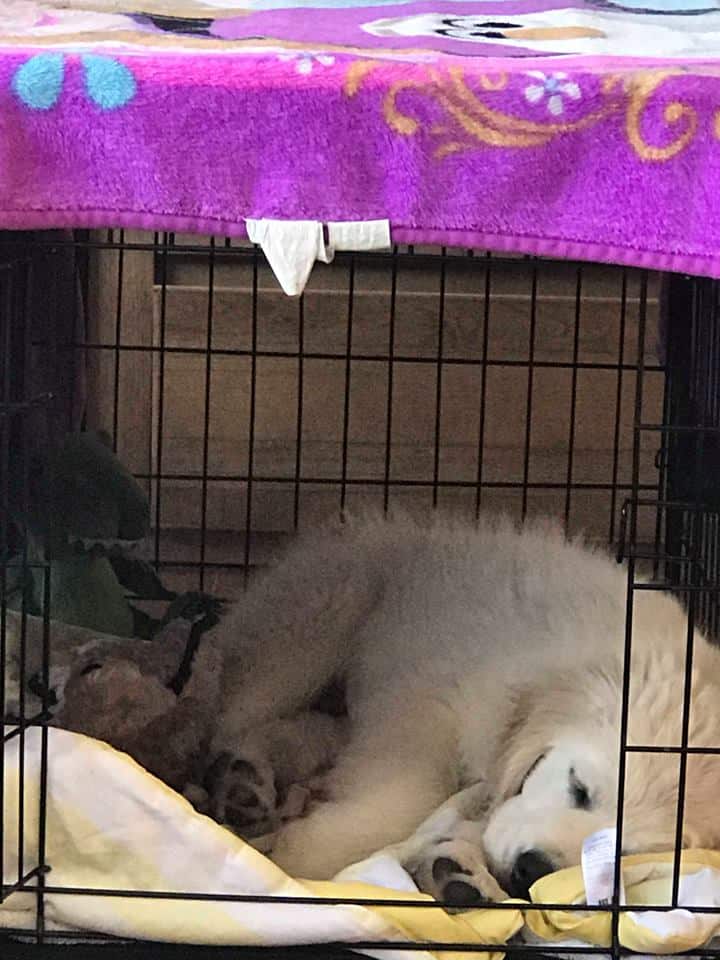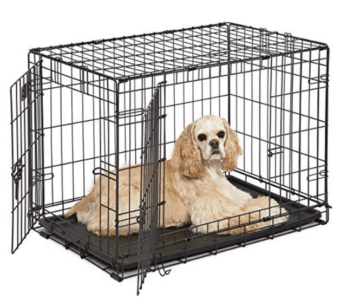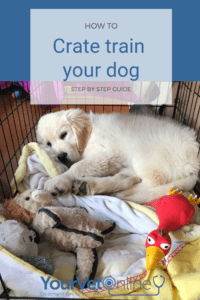How To Crate Train Your Dog
[easy-social-share]
Crate training your new dog or puppy is one of the first things that most veterinarians and trainers recommend you do when you bring your new family member home.
The key to crate training a puppy is that the crate will become your dog’s “happy place”. The crate is the place they will retreat to have some time out, to sleep, to eat or to hide if they are worried.
It is crucial then that we introduce our new dog or puppy to the crate in a way that doesn’t make the crate scary or bad.
Read on to learn the key steps on how to crate train your dog effectively.
What Is Crate Training?
Crate training is the process of teaching your puppy or older dog to spend time in a crate or kennel.
Like Kylie mentioned in her article “Why crate training makes bringing home a puppy so much easier” there are many benefits to crate training, the big benefits for most of us are:
- Safety: we know where our pup or dog is when we can’t supervise them directly
- Toileting: while in the toilet training process we can ensure that they aren’t running around the house peeing in inappropriate places. Crate training can actually speed up the toilet/potty training process.
- Sleeping: providing them with their very own den where they can go and feel safe.
- Our possessions are kept safe: we know how pups like to chew and get into things like shoes, clothing, kids toys.
What Size Crate Does My Dog Need?
There are many crates on the market. My personal favourites are those that have two doors, a roof and a solid floor with a lip to prevent spillage of liquids out of the crate.
I also like the metal collapsable pen-type crates as opposed to the fabric crates that are often used for the short term.
As far as what size to purchase, consider how big your pup will be when fully grown. If you wish your pup to continue using the crate into adulthood then you will need to choose one that they can stand up and turn around easily in when they’re fully grown.
Some pet centers will rent out crates so you may start off with one of a smaller size and upgrade as your dog gets bigger.
If you have got a very large crate, you might also need to block off an area so that your dog doesn’t learn to use one end as a toilet.
Video: Dr Leigh Explains A Crate Training Schedule
How To Crate Train Your Dog
Before we go any further the BIG NUMBER ONE RULE is that you must NEVER use the crate as ‘the naughty corner’ or the place where you send your pup as a punishment for doing something wrong.
The second rule: Try to exercise or play with your pup before putting them in the crate. You wouldn’t enjoy waking up, going for a pee then getting put into a crate again, would you?
The whole purpose of crate training is designed so that this is their safe den. With that in mind, let’s look at how you can start the process of crate training.
-
Introduce Your Dog To The Crate
Have the crate set up in an area where you want it to stay. Ideally, this is in a family area so that your dog still feels like part of the family and isn’t shut away by their lonesome.
Put a blanket or bedding in the crate and any toys that you wish the pup/dog to play with.
Have the doors of the crate open.
Using very small titbits of treats (tiny, you don’t need to give very much at all), throw the treats into the crate and let your pup go in, grab the treat and come out if they wish. If your dog isn’t food motivated, try this process with a favourite toy.
Continue doing this until they are quite happy and relaxed in the crate. Don’t try to close the door just yet.
This whole process might take a day for some pups, but days for other dogs. Older dogs may take longer depending on their previous experiences.
2. Feed Meals In The Crate
Once your pup is going into the crate at free will to retrieve treats and will hang out in it comfortably, try feeding their meals in the crate.
Pop your dog’s meal inside the crate and show them that that is where they need to stay to eat.
Initially, keep the door open so they can come and go as they wish.
You might need to start with the food placed close to the entrance (this is often the case with older dogs who may have bad memories of a crate).
As your dog begins to be more comfortable eating near the door of the crate, move the food further into the crate so it is placed near the back of the crate and your pup is still happy to eat it.
3. Shut The Door To The Crate
While your pup is eating their meal at the back of the crate, shut the door.
Keep watch, as you want to open the door immediately that they have finished eating. Do this for a few meal times.
Next, keep the door closed for a few minutes after they have eaten.
Warning! You want to open the door BEFORE they show any sign of distress or crying/whining. This is when most people make the most mistakes.
If in the process of crate training they begin to whine or cry you need to shorten the time that you have the door closed. You must let them out when they are NOT crying or whining.
Work your way up until your pup is happy to stay in the crate with the door closed for at least 10minutes after eating.
4. Extend Time In The Crate
Now that your pup is happy staying in the crate for up to 10 minutes you can practice calling them to enter the crate at other times and staying for longer.
RECOMMENDED FOR YOU:
PUPPY VACCINATIONS: What Vaccines Do Pups Need And When?
What does paralysis tick do to dogs and cats?
I usually call the crate the kennel, friends of mine call it the ‘den’. Choose how you will refer to the crate and ask your dog to ‘get into the kennel’. Give them a treat and close the door.
Sit or do something near the crate for at least 5minutes then move out of eyesight. Don’t go for too long. The key is to return to the room before your pup gets anxious and starts making a noise.
Slowly lengthen the period of time that your pup can handle this for. We want to be able to leave the room for at least 30mins.
Where many people get it wrong is that you want your pup to think that being IN the crate is the best part. Whatever you do DON’T make leaving the crate the fun, exciting, happy, treat-filled part.
When you open the door to the crate to let your pup out, turn your back and ignore your pup for at least a minute.
5. Leaving Your Dog Crated For Longer Periods
Many people ask how long can you leave a pup in a crate for. My general rule of thumb is that puppies under 6months of age shouldn’t be in a crate for more than 3 or 4 hours at a time. Young pups just can’t control their bladder for longer than 4 hours. This means you will need to get up at night for a toilet break.
Once you can trust your pup to be in the house alone, then you don’t need to keep them locked up in the crate. The crate can be left open and it is the place they go to voluntarily.
How To Stop My Pup Whining When In The Crate?
If your pup is whining and crying, you need to go back to basics. Ensure that you let them out before they whine. If they start whining after 5minutes, you need to open the door at 4m30sec!
The biggest mistake I see people make is that they have too much fun with the pup when they open the door to the crate.
I cannot stress more – you want to IGNORE the puppy when you open the crate.
This is important at ALL stages of training. Even when you have been away for a few hours.
RECOMMENDED FOR YOU:
Desexing your pet – what you need to know
How To Choose The Best Dog Food
It’s important to ignore the whining when it occurs. ONLY open the crate door when the whining stops.
If the whining is occurring at night, wait until it stops, then take puppy to their toilet area. Return to the crate and go back to sleep. Don’t talk to puppy, play or make exciting gestures. Night time is for sleeping.
Be warned that it can take weeks for a puppy to stop whining at night. And there are no easy fixes, unfortunately. It’s important to be prepared for your puppy’s first night at home as it will be tough.
Is Crate Training Worth It?
A dog that is able to be confined in a space that you wish it to stay is one that can go anywhere.
You never know when you might want to put your dog on a plane to move countries. Perhaps they need to stay at a kennel or the veterinary clinic for a few days.
Teaching your puppy or a new dog how to stay in a crate without stressing out, sets up your dog for success.
Tell us how you crate trained your new dog or puppy below. What was the most difficult part for you?
[easy-social-share]







Leave A Comment